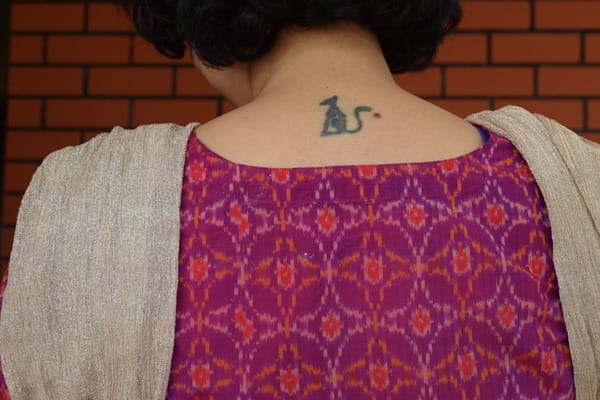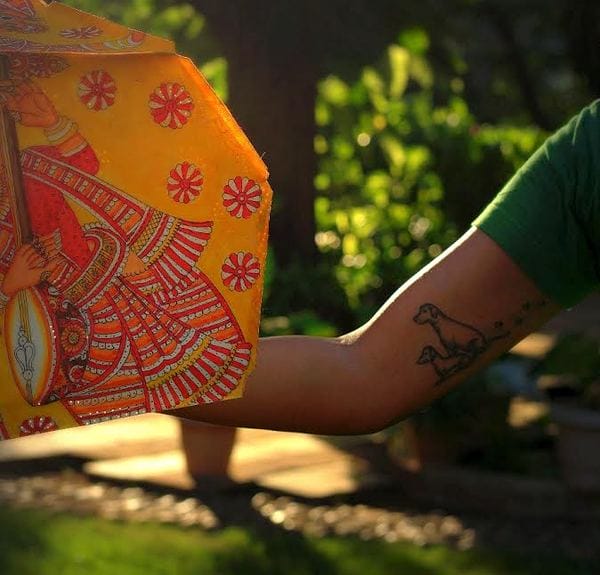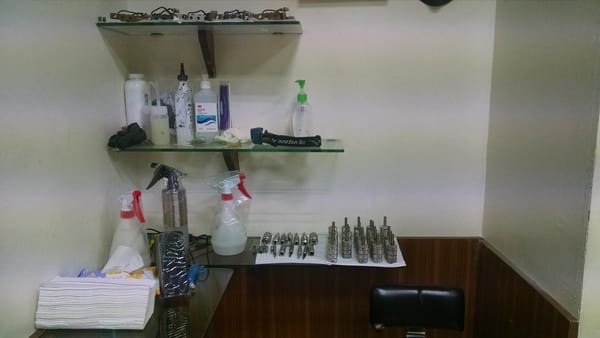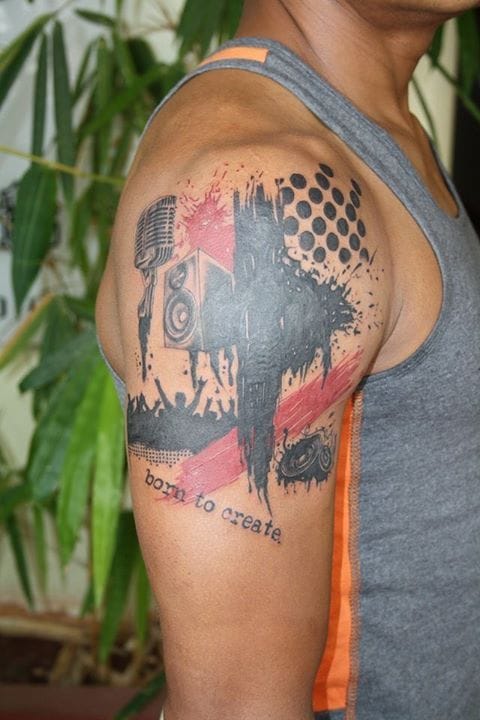“The tattoo is the mark of the soul. It can act as a window we can see in, or it can be a shield to protect us from those who can see past the surface.” – Author unknown
It was the year 2006 when an 18-year-old girl decided to get tattooed. While it had been playing on her mind for sometime, she was yet to decide what she wanted and by whom she would get it done. One fine day, walking down Commercial Street in Bengaluru with a friend, she saw a board that said ‘Tattoos’ and in she went. About an hour later, she had on the nape of her neck, an Egyptian cat—all for a princely sum of Rs 400. A few months later, her friend followed suit. The two of them made their way to the same artist and several hours laters, they both had a tattoo each—one a bar code and the other, a lettered tattoo that spelled ‘tribal’ in Elven script. Or so they thought…

A botched up tattoo. Pic: Gokul M
Today, eleven years later, the Egyptian cat resembles a cross between a mongoose and a dog, the bar code has smudged into a rectangular blob and the lettering it turns out, is wrong. And if you haven’t realised by now, yours truly is the proud bearer of the hybrid animal tattoo.
And what could the moral of this little anecdote be? There are several in fact. Give oneself time to decide what tattoo you want. Do ample research about the artist who will be tattooing you. And finally, you get only as much as your pay. Well, it all bottles down to one simple thing—choose wisely before getting a tattoo.
It has become rather commonplace for young people to want to get tattooed. Many young people are vying to get their first tattoo the second they turn 18. Others wait a while to know what they really want. And with every city or town having its fair share of talented artists, there’s no stopping them.
If you are considering getting inked, here’s what you should keep in mind from start to finish—from the time you think about it, to what you need to do to take care of your tattoo.
The origin of tattoos
Tattoos in India:
In India, the practice has existed for a long time, though there are no records that definitely state since when. Tattoos were sometimes considered as a form of adornment. They were also seen as talisman, to ward off evil. Indigenous tribes used tattoos to mark their identity. Many of the ancient tattoo designs drew inspiration from nature and included birds, animals, and even symmetric and geometric patterns. The kolam design in particular is said to have been worn to confuse Yama, the god of death. (Source: Inked by Margo De’Mello)
In the 1900s, Korathis (gypsies) roamed about the country, bestowing blessings and tattooing those who sought them out. The tattoos were done using three or more needles held together with a thread. The dyes used consisted of a mix of cow or human milk, soot, betel leaf juice and turmeric among others. (Source: Land of Eternal Ink)
Sister Fathima, a nun from Ooty recalls a school trip to a fair in Kerala when she was a child. She has a tattoo of a cross at the base of her thumb. She says that the tattoo served as a constant inspiration for her to join the convent.
In Tamil Nadu tattoos are referred to as ‘pachai’. Lakshmi, a domestic worker sports one on her wrist. She says that she was tattooed in her village, when she was all but eight years old. She also recalls that she had a burning fever for about two days after she was tattooed. Similarly in Karnataka they are called ‘hachche’.
The Gonds of Central India, one of India’s largest tribes, traditionally left much of their bodies exposed. The bare skin was covered with kohkana (Gondi for tattoos) to ensure they looked decent. While young girls would be tattooed in their infancy on their backs, waist, arms and face, the tattoos are much smaller nowadays. In addition to wearing more clothes, the women get tattooed on their forehead and chin with a half moon and three stars. (Source: Tweaking Traditions)
The word tattoo is said to have originated from the Tahitian word ‘tatau’ which means ‘to mark something’. There is also speculation that the word is derived from the Polynesian word ‘ta’, meaning ‘to strike something’. Tattoos are said to have been discovered by accident—someone with a wound may have rubbed it with a sooty hand from the fire and once the wound healed, they were left with a permanent mark.
The history of tattoos goes back a long way, to the third century BC. In 1991, Europe’s oldest mummy was found in Similaun mountain in the Otztal Alps. Otzi as he came to be known was estimated to have lived around 3,300 century BC. His body bore over 50 carbon tattoos, the most significant of them being a cross on the inside of his knee and a series of parallel lines near his spine and ankles. These tattoos are thought to have been made by a series of fine cuts, into which charcoal was rubbed in. (Source: National Geographic)
Why do people want to get tattooed?
Pradeep Menon, founder of Dark Arts Tattoo in Bengaluru says, “People want to get tattooed for a variety of reasons. To remember a particular moment of their life. To commemorate the death of a loved one or a pet – these are called memorial tattoos. Some people get spiritual tattoos to remember a change in their life as a result of a religious event or a supernatural force they have felt. Then there are those who get it merely because it is fashionable.”
The first three categories are typically people who have already decided what they want. They form the main clientele for tattoo artists. They take care not only in choosing what they want to sport on their bodies, but also in deciding the location of the tattoo and picking the artist they want to get tattooed by. They spend time with the artist beforehand to decide on the final design they will sport. Menon says that closing on the design takes anywhere between a few hours to a couple of weeks. The only exception here is when people want to get portraits done, they are absolutely sure of what they want to get.

A memorial tattoo of much-loved family pets. Pic: Mihira Appnender
The fourth category of people who want to sport a tattoo because it is fashionable don’t have any idea of what they really want. They hope that the artist will help them decide. Artists sometimes consciously confuse them by showing them an entire repository of designs to choose from.
Menon says, “We do this so they don’t have any regrets later. A tattoo is permanent, something they should be able to relate to in the future too. As much as possible, we dissuade them in the hope that they will come again, once they are sure about what they want.” Many people he sends away come back to him, after they have done substantial research about what they want, where they want it, what theme etc.
Do you really want a tattoo?
Getting a tattoo is something that you need to be absolutely certain about. A tattoo is a permanent mark on your skin and you should be able to relate to it many years down the line. If it is visible to others, they are bound to ask you what it means, and it is nice when you have an interesting story to tell them. It is also a rather expensive affair. Also know that getting it removed is an even more expensive affair, and painful to boot.
What should you get?
You are the best judge to decide what kind of tattoo you want—not your friends and family, not even the tattoo artist. While it is not necessary to go to the artist with the final design, have a basic idea of what you want to get. It could be something that you love, or a quote you have read or even something that you have seen on somebody else.
Also consider where you want to get inked. Some parts of the body are more susceptible to pain than others. The more the flesh, the less painful it will be. Artists typically recommend the forearms, below the knee, the upper back and shoulder blade. Those parts of the body which are bony, like the knees, the shins, below the ankles, the neck, the collar bone, the wrist, the tailbone, groin areas etc are bound to be painful. Rethink your decision to get tattooed on your belly or the inner bicep – as you grow older, the skin tends to sag, and with your skin, so will your tattoo.
As exciting as it may be to get a tattoo as a keepsake for a trip with friends or on a whim, remember that you could end up with a tattoo that does not look good, or god forbid smudges. Also unless you are in a committed relationship, reconsider getting a tattoo with the name of your significant other.
Choosing an artist
Composition of tattoo ink
There are two parts to tattoo ink – the carrier and the pigment. The carrier is typically a mix of alcohol, glycerine, water; this is what keeps the ink evenly mixed. Organic extracts and pigments are added to this to bring out the colour of the ink.
Here are some chemicals that can be found in commonly-used colours.
- Black – carbon, nickel
- Red – cadmium, mercury
- Yellow – sulphur, lead
- Orange – cadmium
- Blue – copper sulphate
- Green – lead, aluminum
Apart from Calcutta Black, a type of black ink that is also used for calligraphy, most other professional inks are manufactured abroad.
Research well before you decide who you want to get tattooed by. Check if the artist has a website or Facebook page to know the kind of work he/she has done in the past. Also consider if the artist’s style of tattooing matches the kind of tattoo you want to get. While any artist should be capable of doing simple script based tattoos, if you are considering getting a large tattoo with colour and intricate design, make sure you pick the right person. Do ask around and read up reviews to gauge what other people think about the artist’s work.

Equipment laid out ready for use at a tattoo parlour. Pic: Ganga Madappa
It is also extremely important to pay a visit to the tattoo studio before your appointment itself. Ensure that the place is clean and looks hygienic. Ask the artist questions – are his tools sterilised, what kind of ink does he use, where he disposes the waste, what happens in case of a medical emergency. Check if he’s wearing gloves and a mask, and if his fingernails are clean. Also look out for the general appearance of the artist who will be tattooing you; better still if you watch him tattooing somebody else.
Discussing the design

Communication is key. Tell the artist what you want and what you don’t want as well. Carry references of pictures that may be helpful. Understand what style of tattooing would be best suited for the design you have in mind. Once you have done this, the artist will create a custom drawing of what the tattoo will look like. If you are not satisfied, it is alright to tell the artist that. You should also discuss how much it will cost you. While you can certainly try negotiating with the artist, being cheap might just result in you stepping out of the studio with a cheap looking tattoo. Also find out how long it will take and if you will need to come in for multiple sessions. Larger tattoos, and those with intricate details will typically take longer.
A tattoo in the trash-polka style. Pic: Dark Arts
Dos on T-Day
-
Ensure you rest and eat well before you get your tattoo. Stay hydrated as well.This helps the body rejuvenate quickly.
-
Have a shower before you go. Just as you find body odour unpleasant, so will your tattoo artist. Go easy on the perfume too, considering the the artist will be in close proximity to you.
-
Wear comfortable clothes. If you are getting your tattoo on a usually covered part of the body, consider wearing a vest or a tank top so it is easy for the artist to access.
-
Do attend nature’s call before the artist starts tattooing. You do not want to interrupt the artist, mid-session.
-
Take a friend or family member along for moral support.
-
Getting a tattoo is painful. While men do get bigger tattoos, women can apparently tolerate the pain better. Prepare yourself mentally for the pain as well as the discomfort, considering that you may have to remain in one position for the entire duration of the tattoo.
What are the don’ts?
-
Do not consume any alcohol for at least a day before you get tattooed. Alcohol thins the blood, so you are likely to bleed more; this also means that the dye will not sit well.
-
Do not take any painkillers to numb the pain. In all likelihood, the artist will apply a local anesthetic before he begins work.
-
Do not ingest any narcotic substances. Narcotics cause the skin to become insensitive, so despite how much effort the artist makes to push the dye into the skin, the skin will not respond to it and will reject it.
A responsible artist is likely to postpone your appointment if he knows that you are under the influence.
What should you look out for?
-
If the artist has a cold or a cough, ensure that he wears a mask. Also ensure that he is wearing gloves before he starts working.
-
Ensure that the artist is using a new needle. Most artists give the needles to their clients once they are done tattooing. If this happens, ensure you dispose it responsibly.
-
Some people tend to hyperventilate or have an anxiety attack when they are getting their first tattoo. This is because the body release endorphins to counter the pain. This can sometimes result in a head rush, where you may pass out for some time. Prepare yourself mentally for the pain and stay calm to avoid this.
Post tattoo care
Tattoo parlours in Bengaluru
Dark Arts, Koramangala
Ph: 98860 99000, 98452 91930
Email: darkartsthetattoostudio@gmail.com
Brahma Tattoo, Church Street
Ph: 94482 00145, 98442 00145
Email: tattoogiri@hotmail.com
The Ink Movement, Koramangala
Ph: 97426 89804
Email:theinkmovement@gmail.com
Tattoo removal
Kosmoderma, Domlur
Ph: 080 – 41525222 / 25352211
Email:indiranagar@kosmoderma.in
Caring for your tattoo is as important as choosing the design and placement. The artist will give you instructions that you need to follow to ensure that the tattoo heals properly and does not flake away.It is imperative that you follow these instructions so that your tattoo looks nice and crisp in the years to come.
Once you have been tattooed, your artist will dress the area and prescribe an antibacterial ointment that you can use. Based on the kind of dressing it is, it will need to be removed in 1.5 hours or 6 hours. Once you have removed the dressing, wash the area with a mild soap and drinking water, and leave it to dry for about 12 hours. Before you go in for your shower, apply vaseline over the area, so that water doesn’t seep in. After your shower, wash the area once again with a mild soap and drinking water. Pat the area dry with a towel; do not scrub it as you might just scrub away some part of the tattoo as well. Apply the ointment about four times a day.
While your tattoo heals, scab is bound to form over the area. While some of it comes off as and when you apply the ointment, it is imperative that you do not peel the scab. Peeling the scab is akin to peeling your tattoo off. Within a week after you have gotten your tattoo, a shiny layer forms over it. And in two weeks, you will have a shiny, spanking new tattoo.
It is also important not to expose the tattoo to sunlight for at least a month after you have gotten it. Exposing it to the sun causes the tattoo to get faded. Also avoid getting into the sea or a chlorinated pool. Some people are allergic to certain colours like red and yellow, and this could pose a problem if they don’t follow instructions for post tattoo care. Yellow has contents of sulphur, and therefore should not be exposed to direct sunlight immediately after the tattoo is done. Red has components of cadmium and mercury. While mercury as an oxide is accepted by the body in small doses, it produces a toxic chemical which the body does not accept when exposed to sunlight. This could result in a raised tattoo in areas where the colour is present or rashes.
Post one month, ensure you use a sunscreen of SPF 50 and above, anytime you get into water or are out in the sun.
Touching up or modifying a tattoo
You may sometimes need to get a tattoo touched up if the colour has faded. A tattoo can be touched up only for a maximum of three times. Beyond that, it is likely that the skin will get damaged and keloids will form, giving the tattoo an embossed look. This should be kept in mind by those looking to modify or extend a tattoo as well.
Tattoo removal
While getting a tattoo is painful in itself, getting the tattoo removed is even more so. One gets into this situation if the tattoo becomes irrelevant for whatever reason, or if the tattoo itself has been botched up by the artist.
There are two methods to removing a tattoo – skin grafting and laser removal. In skin grafting or excision, a portion of the skin is surgically removed. This is suitable for smaller removals. It also leaves scars and is therefore not very suitable for larger areas. In laser removal, the pigment is broken down into smaller particles that can be easily absorbed by the skin. Larger tattoos will require multiple sessions, and can sometimes take several years for the removal.
Tattoo removal is also an expensive procedure. While you may spend around Rs 3,000 to 4,000 for 2 inch x 2 inch tattoo, getting it removed could cost you upwards of Rs 10,000. All the more reason why you should think twice before getting a tattoo.
For those of you who are now feeling enthused to get out and get yourself a tattoo, here are three things we would like to reiterate.
-
Give yourself time to decide what tattoo you want.
-
Do ample research about the artist who will be tattooing you.
-
And finally, you get only as much as your pay.
Well, it all bottles down to one simple thing—think before you get inked.
(With inputs from Pradeep Menon, Dark Arts)
Very informative Ganga. Got me started thinking about the ink now…..